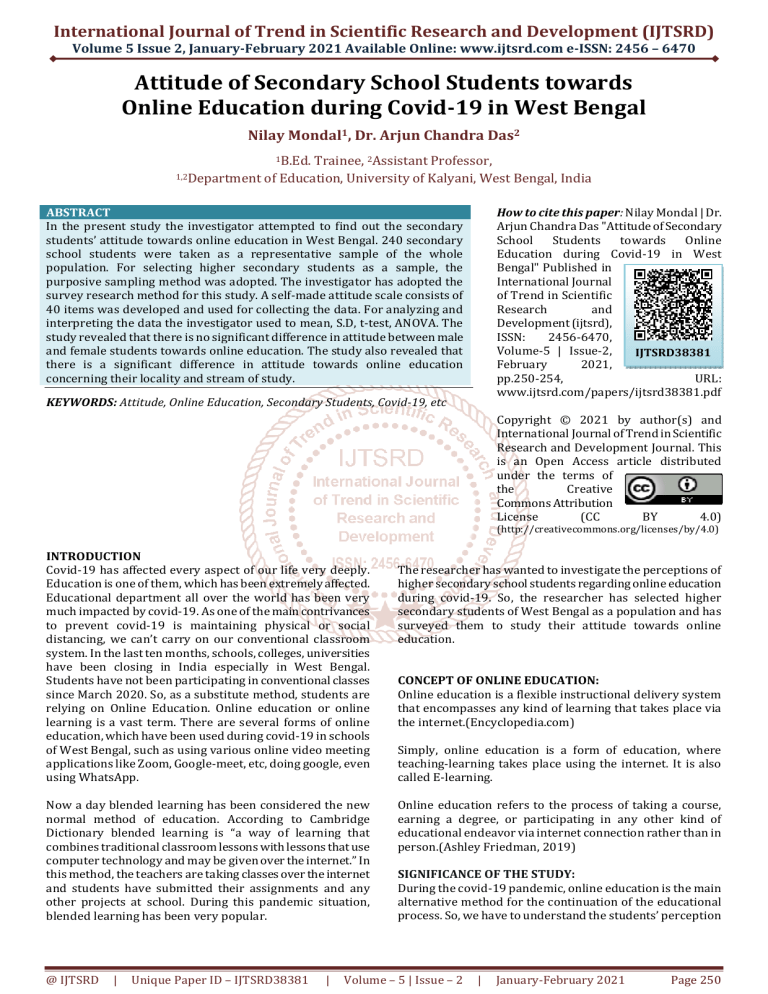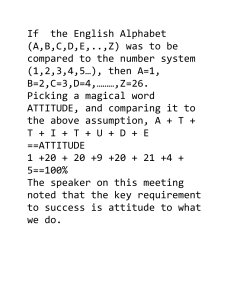
International Journal of Trend in Scientific Research and Development (IJTSRD)
Volume 5 Issue 2, January-February 2021 Available Online: www.ijtsrd.com e-ISSN: 2456 – 6470
Attitude of Secondary School Students towards
Online Education during Covid-19 in West Bengal
Nilay Mondal1, Dr. Arjun Chandra Das2
1B.Ed.
Trainee, 2Assistant Professor,
1,2Department of Education, University of Kalyani, West Bengal, India
ABSTRACT
In the present study the investigator attempted to find out the secondary
students’ attitude towards online education in West Bengal. 240 secondary
school students were taken as a representative sample of the whole
population. For selecting higher secondary students as a sample, the
purposive sampling method was adopted. The investigator has adopted the
survey research method for this study. A self-made attitude scale consists of
40 items was developed and used for collecting the data. For analyzing and
interpreting the data the investigator used to mean, S.D, t-test, ANOVA. The
study revealed that there is no significant difference in attitude between male
and female students towards online education. The study also revealed that
there is a significant difference in attitude towards online education
concerning their locality and stream of study.
How to cite this paper: Nilay Mondal | Dr.
Arjun Chandra Das "Attitude of Secondary
School
Students
towards
Online
Education during Covid-19 in West
Bengal" Published in
International Journal
of Trend in Scientific
Research
and
Development (ijtsrd),
ISSN:
2456-6470,
Volume-5 | Issue-2,
IJTSRD38381
February
2021,
pp.250-254,
URL:
www.ijtsrd.com/papers/ijtsrd38381.pdf
KEYWORDS: Attitude, Online Education, Secondary Students, Covid-19, etc
Copyright © 2021 by author(s) and
International Journal of Trend in Scientific
Research and Development Journal. This
is an Open Access article distributed
under the terms of
the
Creative
Commons Attribution
License
(CC
BY
4.0)
(http://creativecommons.org/licenses/by/4.0)
INTRODUCTION
Covid-19 has affected every aspect of our life very deeply.
Education is one of them, which has been extremely affected.
Educational department all over the world has been very
much impacted by covid-19. As one of the main contrivances
to prevent covid-19 is maintaining physical or social
distancing, we can’t carry on our conventional classroom
system. In the last ten months, schools, colleges, universities
have been closing in India especially in West Bengal.
Students have not been participating in conventional classes
since March 2020. So, as a substitute method, students are
relying on Online Education. Online education or online
learning is a vast term. There are several forms of online
education, which have been used during covid-19 in schools
of West Bengal, such as using various online video meeting
applications like Zoom, Google-meet, etc, doing google, even
using WhatsApp.
Now a day blended learning has been considered the new
normal method of education. According to Cambridge
Dictionary blended learning is “a way of learning that
combines traditional classroom lessons with lessons that use
computer technology and may be given over the internet.” In
this method, the teachers are taking classes over the internet
and students have submitted their assignments and any
other projects at school. During this pandemic situation,
blended learning has been very popular.
@ IJTSRD
|
Unique Paper ID – IJTSRD38381
|
The researcher has wanted to investigate the perceptions of
higher secondary school students regarding online education
during covid-19. So, the researcher has selected higher
secondary students of West Bengal as a population and has
surveyed them to study their attitude towards online
education.
CONCEPT OF ONLINE EDUCATION:
Online education is a flexible instructional delivery system
that encompasses any kind of learning that takes place via
the internet.(Encyclopedia.com)
Simply, online education is a form of education, where
teaching-learning takes place using the internet. It is also
called E-learning.
Online education refers to the process of taking a course,
earning a degree, or participating in any other kind of
educational endeavor via internet connection rather than in
person.(Ashley Friedman, 2019)
SIGNIFICANCE OF THE STUDY:
During the covid-19 pandemic, online education is the main
alternative method for the continuation of the educational
process. So, we have to understand the students’ perception
Volume – 5 | Issue – 2
|
January-February 2021
Page 250
International Journal of Trend in Scientific Research and Development (IJTSRD) @ www.ijtsrd.com eISSN: 2456-6470
of online education. One of the main objectives of this
present study is to understand if the students taking online
classes positively or not. Because we know, there are many
barriers to online education. If students have not a positive
attitude towards online education, we have to think about
the alternative. The findings of the study will help the
teachers, educationists, educational leaders to realize higher
secondary students’ attitudes regarding online education.
And also, this study will stimulate other researchers to carry
out this type of research work in the future.
REVIEW OF RELATED STUDIES:
Gupta and Sharma (2018) conducted a study to find out the
attitude of senior secondary students towards e-learning in
relation to their gender, residential backward, and the
nature of the school. The findings presented that male
students had a greater attitude towards e-learning than
female students. With relation to residential backward had
no significant difference in attitude and also, according to the
stream of study had no significant difference in attitude.
Paris, P. (2004) carried out an investigation entitled ‘Elearning: a study on secondary students’ attitude towards
online web-assisted education’. He discovered that some
students engaged and accepted the use of online webassisted learning(owal) to supplement their learning, if not
at school, then at home. The data indicated that owal would
aid in the learning process of students because students had
a positive attitude towards the use of OWAL.
Konwar, I. (2017) examined college students’ attitude
towards e-learning with special reference to North Lakhipur
of Lakhipur District of Assam. The researcher used a fivepoint Likert type scale developed by Dimpal Rani to collect
the data. The findings from that study were the attitude of
college students towards e-learning was independent
concerning gender and locality. The study suggested that it
had a greater probability of e-learning that they would
accept it. Investigator concluded that college students were
ready to take the opportunity of online learning mode.
of secondary school students towards online education
during covid-19 in West Bengal”.
OBJECTIVES OF THE STUDY:
The present study was carried out to achieve the following
objectivesTo find out the attitude of secondary school students
towards online education.
To identify the difference in the attitude of secondary
students towards online education concerning their
gender.
To study the difference in the attitude of secondary
students towards online education concerning their
locality.
To explore the difference in the attitude of secondary
students towards online education concerning their
stream of study.
To determine the difference in the attitude of secondary
students towards online education concerning their
gender, locality, and stream of study.
HYPOTHESIS OF THE STUDY:
The following hypothesizes were selected for the present
studyH1: There is significant difference in attitude towards
online education between boys’ and girls’ students of
secondary school.
H2: There is significant difference in attitude towards
online education between rural and urban students of
secondary school.
H3: There is significant difference in attitude towards
online education between the arts and science stream
of education of secondary school.
H4: There is significant difference in attitude towards
online education among gender, locality, and stream of
study of higher school students.
DELIMITATION OF THE STUDY:
Area of study: The sample of the present study was taken
from Murshidabad and Nadia District only.
Nachimuthu, K. (2020) researched ‘student teacher’s
attitude towards online learning during covid-19’. The
researcher observed that there is no significant difference in
attitude between male and female students towards online
teaching. He found a significant difference in attitude
between private and government student teachers towards
online teaching and also noticed a significant attitude
between science and arts stream towards online teaching.
Sample size: Only 240 samples were studied during the
investigation.
Ullah et. al. (2017) explored students’ attitudes towards
online learning at the tertiary level. And the result showed
that no significant relationship between the interests’ level
of students in computer and the acquisition of knowledge
through online learning at the undergraduate level.
The present research work was delimited to the higher
secondary school students only (11th and 12thclass).
STATEMENT OF THE PROBLEM:
After studying the previous review literature, the
investigator found the research gap and he selected the
problem as “Attitude of secondary school students towards
online education during covid-19”.The present study was
driven to find out if there any difference in attitude towards
‘online education’ of students in relation to their ‘gender’,
‘locality’, and ‘stream of study’ during COVID-19 in West
Bengal. So, the researcher has entitled the study as “Attitude
OPERATIONAL DEFINITION OF KEY TERMS:
Attitude: Attitude is one kind of feeling by which a person
positively or negatively judges something or someone.
Attitude is always organized towards something or someone.
@ IJTSRD
|
Unique Paper ID – IJTSRD38381
|
Tools: The researcher used a close-ended questionnaire only
for this study.
Statistics Used: For this study the researcher used Mean, SD,
t-test, and ANOVA.
And also, the study was delimited to the Arts and Science
stream of study only.
According to Colesnick “An attitude is an emotionally toned
predisposition to act in a certain way toward a person,
object, an idea, or a situation.”
Volume – 5 | Issue – 2
|
January-February 2021
Page 251
International Journal of Trend in Scientific Research and Development (IJTSRD) @ www.ijtsrd.com eISSN: 2456-6470
Online Education: Online Education is a form of education
delivered through the help of the internet. According to
IndiaEducation.net “Online Education has electronically
supported learning that relies on the internet for
teacher/student interaction and the distribution of class
materials.”
Secondary Students: By secondary students we mean a
student of class 11th and 12th. After qualifying Madhyamik
Examination a student takes admission to secondary level,
specifically higher secondary level.
METHODOLOGY:
Research Method:
As a research method, the researcher adopted the
Descriptive Survey Method as well as the quantitative
research approach for this present study.
According to Gravetter and Forzano,‘‘a research study that
uses a survey to obtain a description of a particular group of
individuals is called a survey research design’’.
administer a survey to a sample or to the entire population
of people to describe the attitudes, opinions, behaviors, or
characteristics of the population. In this procedure, survey
researchers collect quantitative, numbered data using
questionnaires (e.g., mailed questionnaires) or interviews
(e.g., one-on-one interviews) and statistically analyze the
data to describe trends about responses to questions and to
test research questions or hypotheses.”(Creswell, 2012)
Population:
All the secondary (particularly higher secondary) students
(class 11th& 12th) of West Bengal (India) are the targeted
population of the study.
Sample and Sampling:
A total number of 240 subjects were selected as a sample.
The researcher used the purposive sampling technique for
this present investigation. The researcher collected data
from 140 samples in the rural area (Panchayat) and 100
samples in the urban area (Municipality). Out of 240
samples, 130 were male students and 110 were female
students.
According to Creswell “survey research designs are
procedures in quantitative research in which investigators
Sample Profile:
Table No 1: Sample distribution according to various independent variables
Independent Variables
N
Percentage
Male
130
54.1
Gender
240
Female 110
45.9
Rural
137
57
Locality
240
Urban 103
43
Arts
145
60.41
Stream of Study
240
Science 95
39.59
Total = 240
Tools:
We collect the research data with the help of research tools. So, it is a very important element of research. The researcher
prepared a close-ended questionnaire for higher secondary students to study the attitude towards online education. The
questionnaire is a Likert type scale, which consists of 40 items. The questionnaire was standardized with the help of the testretest reliability method. The coefficient of correlation was 0.77. A sample questionnaire is given in table no-1.
Sl.
No.
1.
2.
3.
4.
5.
Table No 2: Sample Items for measuring student s’ attitude towards online education
Strongly
Statement
Agree
Undecided
Disagree
Agree
I like online classes more than
conventional classes.
Online education is costly.
It is very easy to take classes on online,
I miss my friends during online classes.
We can learn at our own pace with the
help of online education.
Strongly
Disagree
TESTING THE HYPOTHESIS:
Hypothesis-1:
H01: There is no significant difference in attitude towards online education between boys’ and girls’ students of secondary
school.
Table No 3: Attitude towards online education between boys’ and girls’ students of secondary school
Groups
N
Mean
S.D. Mean Difference SED
df ‘t’ value
Level of Significance
Male Students
130 162.93 19.18
0.767
2.62 238
0.292
Not significant at both level
Female students 110 162.163 21.13
@ IJTSRD
|
Unique Paper ID – IJTSRD38381
|
Volume – 5 | Issue – 2
|
January-February 2021
Page 252
International Journal of Trend in Scientific Research and Development (IJTSRD) @ www.ijtsrd.com eISSN: 2456-6470
Analysis: The researcher found from the ‘t-table’ that the critical value of t with 238 degrees of freedom(df) at a 5% level
ofsignificance is 1.97 and the 1% level of significance is 2.60. Our calculated value of ‘t’ is 0.292. Since 0.292 is less than 1.97
(0.292<1.97&2.60), the difference between the two groups is not significant at 0.01 and 0.05 levels.
Interpretation: Hence, the null hypothesis (H01) is accepted and the alternative hypothesis is rejected. It means that there is no
significant difference in attitude towards online education between boys’ and girls’ students of secondary school.
Hypothesis-2:
H02: There is no significant difference in attitude towards online education between rural and urban students of secondary
school.
Table No 4: Attitude towards online education between rural and urban students of secondary school.
Groups
N
Mean
S.D. Mean Difference SED
df ‘t’ value Level of significance
Rural Students 137 160.64 18.99
Significant at both 5%
7.45
2.34 238
3.183
and 1% level
Urban Students 103 168.09 17.16
Analysis: The researcher found from the ‘t-table’ that the critical value of t with 238 degrees of freedom(df) at a 5% level
ofsignificance is 1.97 and the 1% level of significance is 2.60. Our calculated value of ‘t’ is 3.183. Since 3.183 is greater than 2.60
(3.183>1.97&2.60) the difference between the two groups is significant at both 0.01 and 0.05 levels.
Interpretation: Hence, the null hypothesis (H02) is rejected and the alternative hypothesis is accepted. It means that there is a
significant difference in attitude towards online education between rural students and urban students of secondary school.
Urban students have a greater positive attitude than rural students towards online education.
Hypothesis-3:
H03: There is no significant difference in attitude towards online education between the arts and science stream of education of
secondary school.
Table No 5: Attitude towards online education between the arts and science stream of education of secondary
school
Groups
N
Mean
S.D. Mean Difference SED
df ‘t’ value Level of Significance
Arts Students
145 161.09 18.72
4.26
2.02 238
2.10
Significant at 5% Level
Science Students 95 165.35 19.00
Analysis: The researcher found from the ‘t-table’ that the critical value of t with 238 degrees of freedom(df) at a 5% level
ofsignificance is 1.97 and the 1% level of significance is 2.60. Our calculated value of ‘t’ is 2.10. Since 2.10 is greater than 1.97
and less than 2.60 (2.10>1.96; 2.10<2.60) the difference between the two groups is significant at the 5% level.
Interpretation: Hence, the null hypothesis (H03) is rejected and the alternative hypothesis is accepted. It means that there is a
significant difference in attitude towards online education between the arts and science stream of education. The Science
stream of students hasa little greater positive attitude towards online education.
Hypothesis-4:
H04: There is no significant difference in attitude towards online education among gender, locality, and stream of study of
higher school students.
Table No 6: Attitude towards online education among gender, locality, and stream of study of higher school
students
F Tabulated at 5%
Source of Variance df Sum of Squares Mean Square Variance F calculated
and 1% level
Between Groups
2
263.27
131.63
Not significant at
Within Groups
717
266291
371.39
0.35
both level
Total
719
266554
Analysis: From table- 6, it is found that the computed F- value (0.35) is less than the critical value of F for 2 and 717 df at both
5% and 1% level of significance.
Interpretation: Hence, the null hypothesis (H04) is accepted and the alternative hypothesis is rejected. It indicates that there is
no significant difference among the gender, locality, and stream of study of secondary students towards online education.
@ IJTSRD
|
Unique Paper ID – IJTSRD38381
|
Volume – 5 | Issue – 2
|
January-February 2021
Page 253
International Journal of Trend in Scientific Research and Development (IJTSRD) @ www.ijtsrd.com eISSN: 2456-6470
FINDINGS OF THE STUDY:
The following findings are given below obtain from the
above statistical analysis and the interpretation
There is no significant difference in attitude towards
online education between boys’ and girls’ students of
higher secondary school.
There is a significant difference in attitude towards
online education between rural students and urban
students of higher secondary school. Also concluded that
urban students have a greater positive attitude than
rural students.
There is a significant difference in attitude towards
online education between the arts and science stream of
education. Also concluded that the Science stream of
students hasa little greater positive attitude towards
online education than Arts students.
There is no significant difference among the gender,
locality, and stream of study of higher secondary
students towards online education.
CONCLUSION:
From the light of the above results and discussions, we can
say that higher secondary school students of West Bengal
attitude towards online education are more favorable.
Although there is a lot of barriers to online education, the
result showed that students can take classes online. So, the
teachers, educationists, educational planners have to think
that how can online education will be more attractive. Apart
from this Covid-19 pandemic has opened a new era of online
teaching and learning. During the covid-19 crisis based
online teaching-learning process is a more vital role in the
educational setting. Students can use online learning
components in different ways to aid the teaching-learning
process.(Nachimuthu,2020)
REFERENCES:
[1] Creswell, J. W. (2012). Educational Research:
Planning, Conducting, and Evaluating Quantitative
and Qualitative Research (4th ed.). 501 Boylston
Street, Boston: Pearson Education.
[2]
BLENDED LEARNING: Meaning in the Cambridge
English Dictionary. (n.d.). Retrieved December 28,
2020,
from
https://dictionary.cambridge.org/dictionary/english
/blended-learning
@ IJTSRD
|
Unique Paper ID – IJTSRD38381
|
[3]
Encyclopedia of Business and Finance, 2nd ed...
Encyclopedia.com. 16 Oct. 2020. (2020, December
14). Retrieved December 16, 2020, from
https://www.encyclopedia.com/finance/finance-andaccounting-magazines/online-education
[4]
Friedman, A. (2019, March 03). Definition of Online
Education. Retrieved December 16, 2020, from
https://www.theclassroom.com/definition-onlineeducation-6600628.html
[5]
Garrett, H. E. (1979). STATISTICS IN PSYCHOLOGY
AND EDUCATION (6th ed.). Bombay: G. U. Mehta.
[6]
GRAVETTER, F., & FORZANO, L. (2012). Research
Methods for the Behavioral Sciences (4th ed.). Belmont,
CA: Linda Schreiber-Ganster.
[7]
Gupta, M., & Sharma, M. (2018). A Study on Attitude of
Senior Secondary School Students Towards ELearning in Relation to their Gender, Residential
Backward and Nature of school. International Journal
of Engineering, Science and Mathematics, 7(1), 418-43
[8]
Konwar, I. (2017). A study on attitude of college
students towards e-learning with special reference to
North Lakhipur of Lakhipur district, Assam.
International Journal of Information Science and
Education, 4(1), 1-10.
[9]
Mangal, S.K. (2014). Statistics in Psychology and
Education (2nd Ed.). Delhi: PHI Learning Private
Limited.
[10]
Nachimuthu, K. (2020). Student Teacher's attitude
towards online learning during covid-19.
International Journal of Advanced Science and
Technology, 29(6), 8745-8749.
[11]
Paris, P. (2004). E-learning: A study on secondary
students' attitude towards online web assisted
learning. International Education Journal,5(1), 98-112.
[12]
Ullah, O., Khan, W., & Khan, A. (2017). Students'
Attitude towards Online Learning at Tertiary Level.
Humanities and Social Science, 25(1-2), 63-82.
[13]
What is online education? (n.d.). Retrieved from
https://www.indiaeducation.net/onlineeducation/articles/what-is-online-education.html
Volume – 5 | Issue – 2
|
January-February 2021
Page 254




